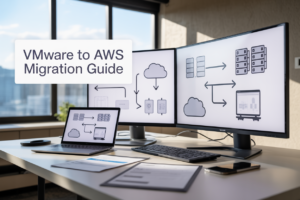AWS login failures pose serious threats to your cloud infrastructure, potentially signaling brute force attacks, compromised credentials, or unauthorized access attempts. This guide helps AWS administrators, security teams, and DevOps engineers implement robust AWS login monitoring best practices to protect their accounts from security breaches.
You’ll learn how to leverage AWS CloudTrail monitoring and native security services to detect authentication failures in real-time. We’ll walk you through setting up automated AWS security alerts that notify you immediately when suspicious login activity occurs, plus show you how to build an effective AWS security incident response plan that minimizes damage from potential breaches.
By the end of this guide, you’ll have the tools and knowledge to prevent AWS unauthorized access attempts before they compromise your systems.
Understanding AWS Login Failure Risks and Impact
Common attack vectors targeting AWS accounts
Cybercriminals frequently exploit weak passwords, stolen credentials, and phishing attacks to gain unauthorized access to AWS accounts. Brute force attacks target IAM users with predictable passwords, while credential stuffing leverages compromised credentials from other data breaches. Social engineering tricks employees into revealing access keys, and malicious insiders abuse legitimate credentials for unauthorized access.
Financial and operational consequences of security breaches
AWS security breaches can drain budgets through unauthorized resource provisioning, cryptocurrency mining operations, and data transfer charges reaching thousands of dollars within hours. Organizations face operational disruptions including service outages, corrupted databases, and compromised customer data. Recovery costs include forensic investigations, legal fees, regulatory fines, and reputation damage that impacts customer trust and future business opportunities.
Compliance requirements for monitoring access attempts
Regulatory frameworks like SOC 2, PCI DSS, and HIPAA mandate comprehensive logging and monitoring of AWS authentication failures and access attempts. Organizations must maintain detailed audit trails showing who attempted access, when attempts occurred, and which resources were targeted. CloudTrail monitoring becomes essential for demonstrating compliance during audits, with requirements for real-time alerting, log retention periods, and documented incident response procedures.
Real-world case studies of compromised AWS environments
The Capital One breach exposed 100 million customer records through misconfigured AWS resources and inadequate login monitoring, resulting in $80 million in fines. Tesla’s cloud infrastructure was compromised when attackers exploited weak Kubernetes credentials to mine cryptocurrency, highlighting the importance of AWS login failure detection. Numerous organizations have experienced massive billing spikes when compromised accounts were used to spin up expensive GPU instances for unauthorized mining operations.
Essential AWS Services for Login Monitoring
CloudTrail Configuration for Comprehensive Audit Logging
CloudTrail serves as your primary defense for tracking AWS login failures and authentication attempts across your entire AWS environment. Enable CloudTrail in all regions to capture every API call, including failed console logins, programmatic access attempts, and MFA failures. Configure data events for sensitive resources like S3 buckets and Lambda functions to monitor unauthorized access patterns. Store CloudTrail logs in a dedicated S3 bucket with proper encryption and access controls. Set up log file validation to detect tampering and create separate trails for different organizational units. Regular CloudTrail analysis reveals suspicious login patterns, unusual access times, and geographic anomalies that could indicate compromised credentials or brute force attacks.
CloudWatch Integration for Real-Time Failure Detection
CloudWatch transforms raw CloudTrail data into actionable AWS security incident response triggers through custom metrics and alarms. Create CloudWatch filters to detect specific AWS authentication failures like repeated failed console logins, disabled user attempts, and root account usage. Set up metric filters for events such as “ConsoleLogin” failures, “AssumeRole” errors, and “GetSessionToken” rejections. Configure CloudWatch alarms with appropriate thresholds – typically 3-5 failed attempts within a 15-minute window triggers immediate notifications. Integrate SNS topics for email, SMS, or webhook alerts to security teams. Use CloudWatch Insights queries to analyze login failure trends and identify attack patterns across multiple accounts and regions.
AWS Config Rules for Security Baseline Monitoring
AWS Config rules provide continuous compliance monitoring for your login security configurations and IAM security policies. Deploy managed rules like “root-user-access-key-check” to detect dangerous root account keys and “iam-user-unused-credentials-check” to identify dormant accounts vulnerable to compromise. Create custom Config rules to enforce password policies, MFA requirements, and session timeout configurations. Set up remediation actions that automatically disable compromised accounts or rotate exposed credentials when violations occur. Monitor IAM policy changes, role modifications, and permission escalations through Config timeline views. Regular Config compliance reports help maintain security baselines and demonstrate adherence to regulatory frameworks while preventing AWS unauthorized access through misconfigurations.
Setting Up Automated Login Failure Detection
Creating CloudWatch alarms for failed authentication events
Start by configuring CloudWatch to track AWS login failures through CloudTrail logs. Create metric filters targeting ConsoleLogin events with errorMessage fields, then establish alarms that trigger when failed authentication attempts exceed normal baselines. Focus on root account access attempts, multiple consecutive failures from single IP addresses, and authentication errors during unusual time periods. Set up custom metrics to capture failed MFA attempts and expired session tokens for comprehensive AWS authentication failures monitoring.
Configuring SNS notifications for immediate alerts
Build SNS topics that deliver real-time alerts when AWS login monitoring detects suspicious activity. Configure email, SMS, and webhook endpoints to ensure security teams receive instant notifications about critical authentication events. Create separate notification channels for different severity levels – immediate alerts for root account compromise attempts and standard notifications for routine failed login attempts. Integrate with ticketing systems and messaging platforms like Slack to streamline automated AWS security alerts and accelerate incident response times.
Establishing threshold parameters for legitimate vs suspicious activity
Define smart thresholds that differentiate between normal user behavior and potential threats in your AWS account security monitoring. Set baseline parameters considering factors like user roles, typical login patterns, and business hours. Configure progressive alert levels: 3-5 failed attempts trigger monitoring, 10+ attempts within 30 minutes escalate to high priority. Account for legitimate scenarios like password resets, new device authentication, and traveling users. Regularly review and adjust thresholds based on organizational changes and emerging threat patterns.
Implementing geographic location-based filtering
Deploy geolocation filtering to detect AWS login failures from unexpected locations and prevent AWS unauthorized access attempts. Configure CloudWatch to analyze source IP addresses against known user locations and approved geographic regions. Create high-priority alerts for login attempts from countries where your organization doesn’t operate or from locations significantly distant from users’ typical access patterns. Implement whitelisting for approved VPN endpoints and office locations while maintaining strict monitoring for access from suspicious or blacklisted geographic regions.
Advanced Monitoring Strategies and Tools
Multi-factor Authentication Failure Pattern Analysis
Organizations can significantly enhance AWS account security by analyzing MFA failure patterns to identify potential threats before they escalate. Advanced monitoring focuses on unusual authentication patterns, including repeated MFA failures from specific IP addresses, failed attempts during off-hours, or multiple consecutive failures across different accounts. Security teams should establish baseline metrics for normal MFA failure rates and configure automated AWS security alerts when thresholds are exceeded. Tracking geographic anomalies in MFA failures helps detect credential stuffing attacks and compromised accounts attempting access from unexpected locations.
Third-party SIEM Integration for Enhanced Visibility
Integrating AWS CloudTrail monitoring with third-party SIEM platforms creates comprehensive visibility across your entire security infrastructure. Popular solutions like Splunk, IBM QRadar, and Microsoft Sentinel can ingest AWS authentication failures alongside other security events for correlation analysis. This integration enables security teams to connect AWS login monitoring best practices with broader threat hunting activities. SIEM platforms excel at identifying attack patterns spanning multiple systems, correlating AWS authentication failures with network intrusion attempts, email security events, and endpoint detection alerts for complete threat visibility.
Machine Learning Approaches for Anomaly Detection
Machine learning transforms traditional AWS login failure detection by identifying subtle behavioral anomalies that rule-based systems miss. AWS GuardDuty leverages machine learning algorithms to analyze authentication patterns and detect unusual access behaviors, including compromised credentials and insider threats. Custom ML models can be trained on historical login data to establish user behavior baselines, automatically flagging deviations that suggest account compromise. These intelligent systems adapt to evolving threats, reducing false positives while catching sophisticated attacks that bypass conventional security measures through behavioral analysis of login timing, device fingerprinting, and access pattern recognition.
Incident Response Procedures for Login Failures
Immediate containment steps for suspected compromised accounts
Suspend the affected AWS account immediately when you detect unusual AWS login failures or authentication patterns. Change all passwords, revoke active sessions, and disable any suspicious IAM users or roles. Remove temporary credentials and API keys that might have been compromised. Document all containment actions taken for your AWS security incident response investigation.
Evidence collection and forensic analysis workflows
Pull AWS CloudTrail logs covering the incident timeframe to analyze login patterns and identify the attack vector. Export relevant logs from CloudWatch and AWS Config for detailed forensic examination. Capture screenshots of suspicious activities, failed login attempts, and any unauthorized resource changes. Create a timeline of events showing when AWS authentication failures began and what systems were potentially accessed during the breach.
Account recovery and security hardening protocols
Reset all compromised credentials and implement multi-factor authentication across all user accounts. Review and update IAM policies to follow the principle of least privilege. Enable additional AWS login monitoring through CloudTrail and set up automated AWS security alerts for future incidents. Conduct a comprehensive security audit of all AWS resources and configurations to identify vulnerabilities that led to the compromise.
Stakeholder communication and reporting requirements
Notify internal security teams, management, and affected business units about the AWS login failure incident within established timeframes. Prepare detailed incident reports documenting the root cause, impact assessment, and remediation steps taken. Communicate with external parties such as customers, partners, or regulatory bodies as required by compliance obligations. Schedule post-incident review meetings to discuss lessons learned and improvements to AWS account security procedures.
Preventive Measures to Reduce Login Failure Incidents
Implementing Strong Password Policies and Rotation Schedules
AWS IAM password policies should require minimum 14 characters with complexity requirements including uppercase, lowercase, numbers, and special characters. Set automatic password expiration every 90 days and prevent password reuse for the last 24 passwords. Configure account lockout after 5 failed attempts to prevent brute force attacks. Strong password policies dramatically reduce AWS login failures by eliminating weak credentials that attackers commonly exploit through dictionary and credential stuffing attacks.
Enforcing Multi-Factor Authentication Across All User Accounts
Enable MFA for all IAM users, especially those with administrative privileges, to create an additional security layer beyond passwords. Deploy hardware tokens, virtual MFA apps, or SMS-based authentication depending on your security requirements. Root account MFA protection is critical since root access provides unlimited AWS account control. MFA enforcement reduces successful unauthorized access attempts by 99.9% even when passwords get compromised, making it the most effective defense against AWS authentication failures.
Regular Access Reviews and Privilege Optimization
Conduct quarterly access reviews to identify and remove unused IAM users, roles, and permissions that could become attack vectors. Implement least privilege principles by granting only the minimum permissions required for specific job functions. Use AWS Access Analyzer to identify unused access rights and overly permissive policies. Regular privilege optimization prevents privilege escalation attacks and reduces the attack surface that could lead to AWS login monitoring alerts and security incidents.
Employee Security Awareness Training Programs
Train employees to recognize phishing attempts, social engineering tactics, and password security best practices that directly impact AWS account security. Create simulated phishing campaigns to test employee responses and provide targeted training for those who fail. Cover AWS-specific security topics like proper IAM key management, recognizing suspicious login alerts, and incident reporting procedures. Security-aware employees serve as the first line of defense against attacks that could trigger AWS login failure detection systems and compromise organizational security.
Protecting your AWS accounts from unauthorized access attacks requires a multi-layered approach that combines smart monitoring, quick response procedures, and strong preventive measures. By setting up automated detection systems through CloudTrail, CloudWatch, and AWS Config, you create an early warning system that catches suspicious login attempts before they become serious security breaches. The key is not just having these tools in place, but making sure they’re properly configured to send alerts when something looks off.
Your security team needs clear incident response procedures and should regularly practice handling different types of login failure scenarios. Don’t wait until you’re under attack to figure out your response plan. Start implementing these monitoring strategies today, beginning with the basics like enabling CloudTrail logging and setting up CloudWatch alarms for failed login attempts. Remember, the cost of prevention is always much lower than dealing with a successful breach that could compromise your entire AWS infrastructure.




















